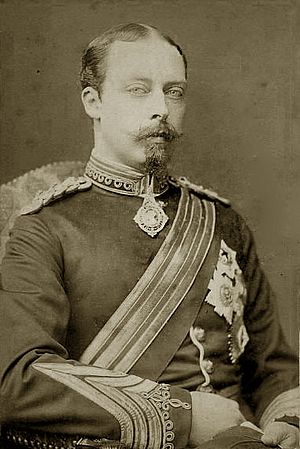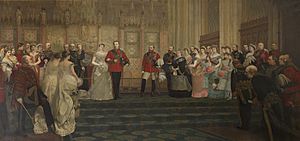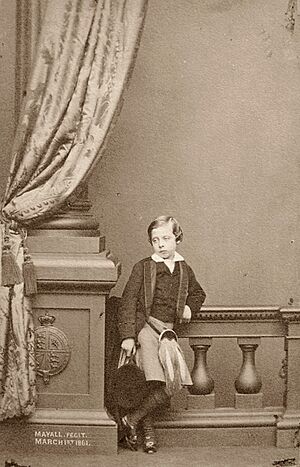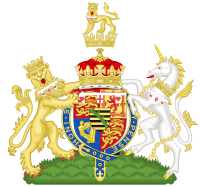Prince Leopold, Duke of Albany facts for kids
Quick facts for kids Prince Leopold |
|||||
|---|---|---|---|---|---|
| Duke of Albany | |||||
 |
|||||
| Born | 7 April 1853 Buckingham Palace, London |
||||
| Died | 28 March 1884 (aged 30) Cannes, France |
||||
| Burial | 5 April 1884 Royal Vault, St George's Chapel, Windsor Castle; 23 June 1885 Albert Memorial Chapel, St George's Chapel |
||||
| Spouse |
Princess Helen of Waldeck and Pyrmont
(m. 1882) |
||||
| Issue | |||||
|
|||||
| House | Saxe-Coburg and Gotha | ||||
| Father | Prince Albert of Saxe-Coburg and Gotha | ||||
| Mother | Queen Victoria of the United Kingdom | ||||
Prince Leopold, Duke of Albany, born Leopold George Duncan Albert (April 7, 1853 – March 28, 1884), was the eighth child and youngest son of Queen Victoria and Prince Albert. He later received the titles Duke of Albany, Earl of Clarence, and Baron Arklow. Leopold had a serious blood condition called haemophilia. This condition made him very fragile and led to his early death at the age of 30 after a fall.
Contents
Prince Leopold's Early Life
Leopold was born on April 7, 1853, at Buckingham Palace in London. He was the eighth child and youngest son of Queen Victoria and Prince Albert. During his birth, Queen Victoria chose to use chloroform to help with the pain. This helped make anesthesia more common for childbirth.
Leopold was baptized on June 28, 1853. His parents named him Leopold after their uncle, King Leopold I of Belgium.
From a young age, Leopold was known to be a delicate child. He inherited haemophilia from his mother, Queen Victoria. This condition affects how blood clots, making even small injuries dangerous. People at the time also thought he might have had mild epilepsy.
Education and Interests
Prince Leopold was very smart from a young age. Famous people like the Poet Laureate, Alfred, Lord Tennyson, noticed his thoughtful mind. His daughter, Princess Alice, later wrote that his love for books and art was encouraged by his tutor, Robert Collins.
Studying at Oxford University
In 1872, Prince Leopold started studying at Christ Church, Oxford. He learned many different subjects. He even became the president of the Oxford University Chess Club. When he turned 21 in 1874, he was given an annual payment of £15,000.
He left the university in 1876 with an honorary degree. After that, he traveled around Europe. In 1880, he visited Canada and the United States. He traveled with his sister, Princess Louise. Her husband was the Governor General of Canada.
Leopold was a big supporter of chess. The important London 1883 chess tournament was held with his help. Because of his haemophilia, he could not join the military. Instead, he supported the arts and literature. He also worked as an unofficial secretary for his mother, Queen Victoria.
Military Connections
Even though he couldn't be an active soldier, Prince Leopold had honorary roles in the military. He was connected to the 72nd Regiment, Duke of Albany's Own Highlanders. From 1881, he was the first Colonel-in-Chief of the Seaforth Highlanders. This regiment was formed by combining two other regiments. A painting of Prince Leopold in his military uniform is kept in the Royal Collection.
Freemasonry Activities
Prince Leopold was an active Freemason. He joined the Apollo University Lodge in Oxford. His brother, Albert Edward, Prince of Wales, helped him join. Leopold led the Lodge from 1876 to 1877. He was also a leader for Freemasons in Oxfordshire until he died. In 1882, he helped start the Masonic Hall in Banbury.
Prince Leopold's Marriage

Prince Leopold wanted to get married to gain more independence from his mother, Queen Victoria. However, finding a wife was difficult because of his haemophilia. He knew Alice Liddell, who was the daughter of an Oxford university leader. She was the inspiration for Lewis Carroll's Alice's Adventures in Wonderland. Leopold was even the godfather to Alice's second son.
He also considered marrying his second cousin, Princess Frederica of Hanover. They became close friends for life. Other women he thought about marrying included Princess Elisabeth of Hesse-Kassel and Princess Stéphanie of Belgium.
Queen Victoria wanted her children to marry into other royal Protestant families. So, she suggested he meet Princess Helen Frederica. Helen was the daughter of Prince George Victor of Waldeck-Pyrmont.
On April 27, 1882, Leopold and Helen were married at St George's Chapel at Windsor Castle. After their marriage, his income increased. They had a happy, but short, marriage. In 1883, Leopold became a father when his wife gave birth to their daughter, Alice. Sadly, he did not live to see his son, Charles Edward, born.
Illness and Death
Prince Leopold was diagnosed with haemophilia when he was a child. He always had doctors with him. In February 1884, Leopold went to Cannes, France, because his doctors suggested it. Joint pain is common with haemophilia, and the cold winter in the United Kingdom was hard on him. His wife, who was pregnant, stayed home but encouraged him to go.
On March 27, at his home in Cannes, he slipped and fell. He hurt his knee and hit his head. He died early the next morning, likely from bleeding in his brain. His body was buried in the Royal Vault and later in the Albert Memorial Chapel at Windsor. The royal court observed official mourning for over a month.
Leopold was the second of Queen Victoria's children to die, and the youngest at 30 years old. His mother lived for another seventeen years, outliving two more of her children. The haemophilia gene is carried on the X chromosome. It is usually passed down through female family members. Leopold's daughter, Alice, inherited the haemophilia gene. She passed it to her elder son, Rupert.
Leopold's son, Prince Charles Edward, was born four months after his father's death. He became the 2nd Duke of Albany. Charles Edward later became the Duke of Saxe-Coburg and Gotha in 1900. Through Charles Edward, Leopold is the great-grandfather of Carl XVI Gustaf, who is the current King of Sweden.
Titles and Awards
Titles Held
- April 7, 1853 – May 24, 1881: His Royal Highness The Prince Leopold
- May 24, 1881 – March 28, 1884: His Royal Highness The Duke of Albany
Prince Leopold was given the titles Duke of Albany, Earl of Clarence, and Baron Arklow on May 24, 1881.
Awards and Honors
Prince Leopold received many awards during his life. Some of these included:
- Royal Knight of the Garter, April 29, 1869
- Knight of the Thistle, May 24, 1871
- Member of the Privy Council of the United Kingdom, October 20, 1874
- Knight Grand Commander of the Star of India, January 25, 1877
- Knight Grand Cross of St Michael and St George, May 24, 1880
He also received many honors from other countries.
Coat of Arms
In 1856, Prince Leopold was given his own special coat of arms. It showed the arms of the kingdom. It also included a smaller shield representing Saxony, his father's family.
| Prince Leopold's coat of arms |
Honorary Degrees
On January 30, 1884, the University of Durham gave Prince Leopold an honorary degree. This was a special award for his achievements. The ceremony took place in the Durham Cathedral Library and many people came to watch.
Prince Leopold's Children
| Image | Name | Birth | Death | Notes |
|---|---|---|---|---|
 |
Princess Alice of Albany | February 25, 1883 | January 3, 1981 | She married Prince Alexander of Teck in 1904. They had three children. |
 |
Prince Charles Edward, Duke of Albany | July 19, 1884 | March 6, 1954 | Born four months after his father's death. He later became the ruling Duke of Saxe-Coburg-Gotha. He married Princess Victoria Adelaide of Schleswig-Holstein in 1905. They had five children. |
Images for kids
See also
 In Spanish: Leopoldo, duque de Albany para niños
In Spanish: Leopoldo, duque de Albany para niños




